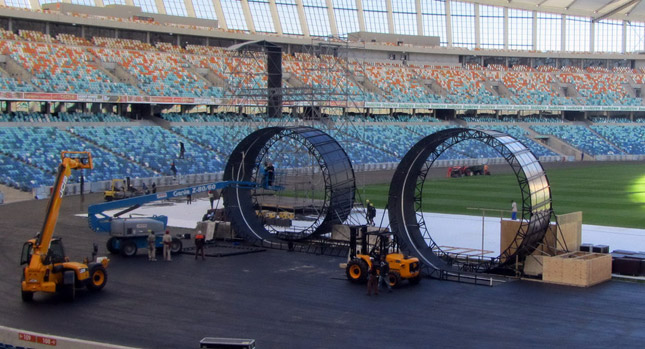The traveling version of the famed Top Gear TV show, which has entertained some 1.2 million viewers in 17 cities around the world over the past years, is almost here, as the next Top Gear Live Festival will take place in the Moses Mabhida Stadium in Durban, South Africa, from June 16 to 17.
For this year’s event, the producers of the show have prepared numerous stunts that will culminate with the Top Gear Live stunt team aiming for a further World Record by attempting to successfully complete a double loop-the-loop feat with a single seater buggy.
The double loop stunt is called the ‘Deadly 720’, and according to Top Gear, this will be the first time anyone has attempted it.
“We’ve designed some pretty outlandish car stunts over the past four years from car bungees in Moscow’s Red Square to jet propelled pushbikes, but this double loop the loop has the greatest chance of going wrong,” stated Top Gear Live Creative Director, Rowland French.
“We’ve completed a single loop the loop as the climax to the previous Carmageddon Tour more than 80 times, and you know barring any acts of God, the buggy will make it through. Adding the second loop, though, multiplies the danger by more than two and creates the very real possibility of the buggy falling out from the top of the second loop. There are absolutely no margins for error, which is probably why no one has ever been mad enough to try it before,” added French.
[From Top Gear Live] Deadly 720: The Facts:
- Deadly 720 is the World’s first double loop the loop stunt and will be attempted by the Top Gear Live Stunt Team during the Top Gear Festival staged in Durban, South Africa on 16-17 June.
- The two loops are each 8 metres tall and comprise of 8 tons of steelwork (16 tons in total).
- If you uncurled both loops, the total length of track would be 58 metres.
- 28 tons of ballast weight is used to prevent the loops from moving during the stunt.
- The buggy is fitted with special hand controls to lock out the accelerator pedal during the stunt as, during testing, the extreme G forces involved forced the driver’s foot to bury the throttle and resulted in the buggy crashing on exit of the loop.
- The dashboard is fitted with a large shift light that goes from red to green when the buggy is at sufficient speed to complete the loop. If you think that takes the fun out of it, think again; with only a 30m run up the shift light will be changing to green a mere five metres before going vertical – not a lot of time to jump on the brakes and abort.
- The buggy must enter each loop between 24 and 26mph to successfully complete the stunt. Failing to achieve the minimum 24mph risks the buggy falling out at the top of the loop. An increase of speed from 26mph will result in an extra G of force on the driver and could cause him to black out.
- The buggy must exit the first loop with sufficient speed to enter the second loop at the prerequisite speed, a challenge that’s far easier said than done. The buggy needs a minimum 30 metre run up to gain enough speed to complete the first loop but only has 8 metres between the two loops to regain the few mph lost during the first 360.
- Entering the loop has been likened to hitting a flat wall at speed as it takes less than a second for the buggy to go vertical.
- Suspension is everything: if the car bottoms out during either loop its chassis will grind the steel floor and swipe off vital MPH just when the driver needs it most. This is well known because the team destroyed two buggies due to suspension issues when testing the single loop in 2009.
- As the team was so concerned regarding the potential dangers when first designing the single loop in 2009 the engineers created a full size, remote control buggy that could be sent through the loop – and potentially fail – without injuring a driver. Only once it had successfully completed a number of loops was a real driver allowed behind the controls.
PHOTO GALLERY











